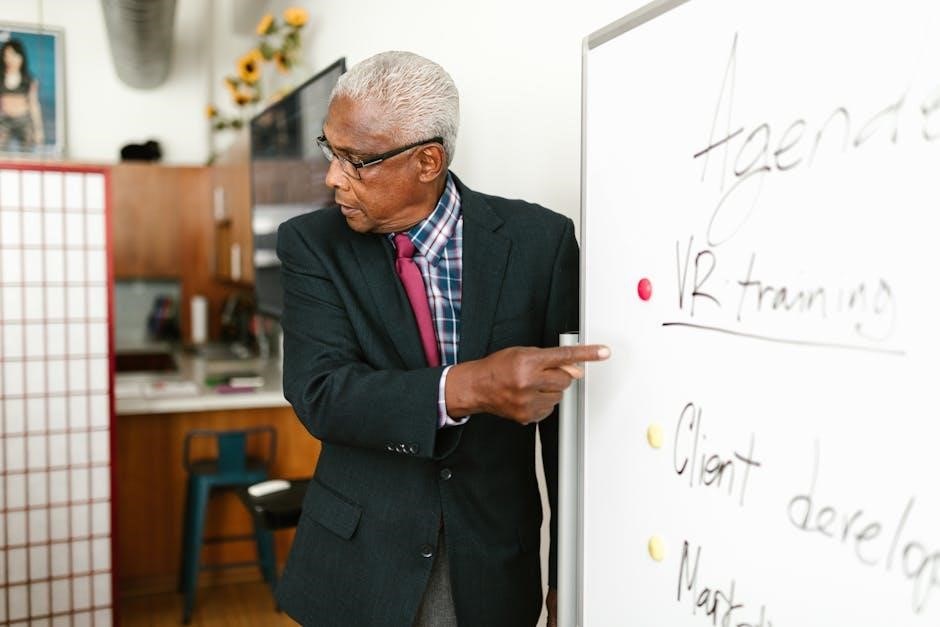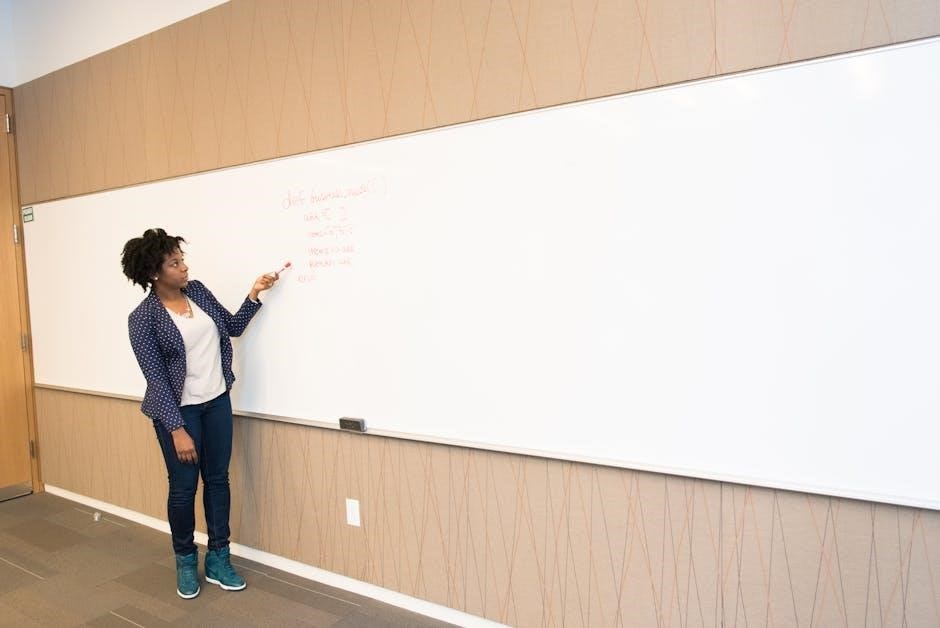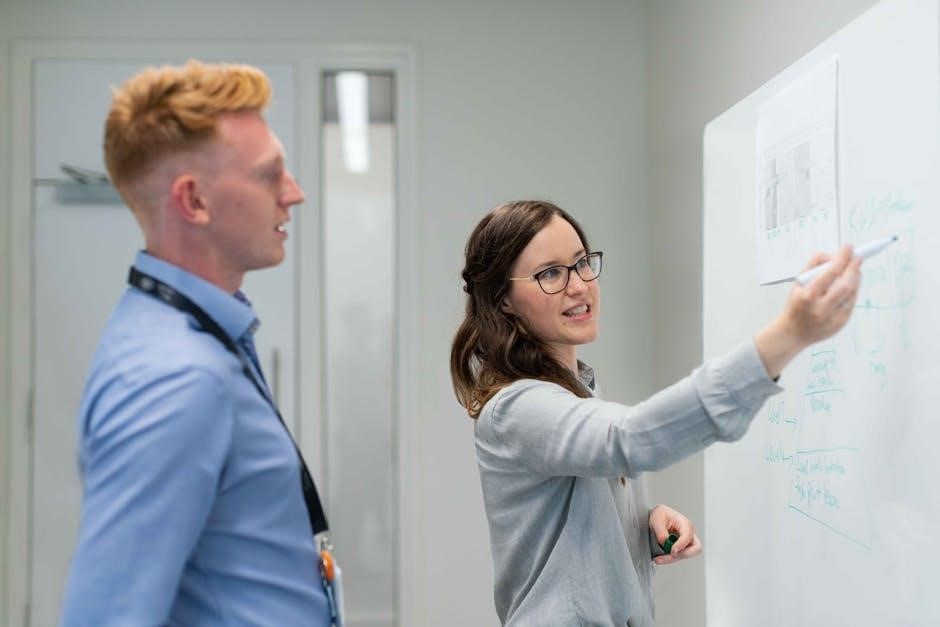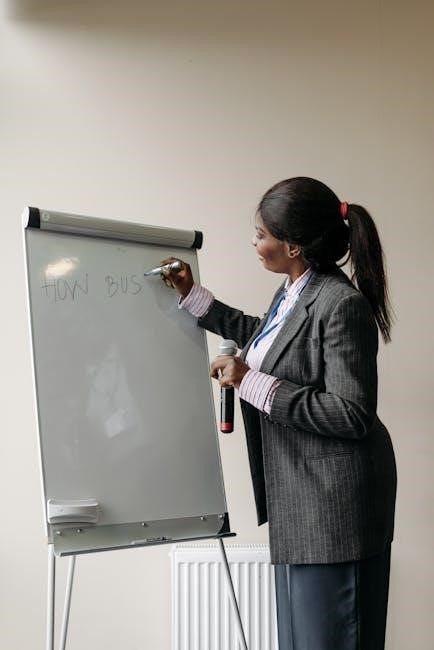The JROTC Leadership Education and Training Program, sponsored by the Department of Defense, provides high school students with structured education in leadership, citizenship, and military science. Cadets develop teamwork, personal responsibility, and respect while preparing for future challenges.
1.1 Overview of JROTC
The Junior Reserve Officers Training Corps (JROTC) is a Department of Defense-sponsored program for high school students in grades 9–12. It focuses on developing leadership, citizenship, and employability skills through structured education and training. Cadets learn teamwork, personal responsibility, and respect while gaining exposure to military science and community service. The program emphasizes character education, providing equal access to all students. JROTC prepares cadets for future challenges by fostering a strong foundation in leadership and civic responsibility.
1.2 Importance of Leadership Education in JROTC
Leadership education is a cornerstone of JROTC, equipping cadets with essential skills to navigate future challenges. By fostering teamwork, decision-making, and problem-solving, JROTC prepares students to become responsible leaders in their communities. The program emphasizes character development, teaching cadets to embrace integrity, respect, and accountability. These leadership attributes not only benefit cadets academically and personally but also empower them to contribute positively to society. Through structured training and real-world applications, JROTC cultivates a generation of ethical and capable leaders.
Structure of the JROTC Program
The JROTC program is structured for high school students, offering leadership, citizenship, and character education through a framework of teamwork, personal responsibility, and respect for all.
2.1 Program Organization and Levels
The JROTC program is organized into structured levels, typically spanning four years for high school students. It begins with foundational courses in leadership and citizenship, progressing to advanced topics in military science and practical leadership. The program is divided into levels, such as first-year cadets focusing on basic leadership skills and upper-level cadets engaging in mentorship and advanced training. Instructors, often retired military personnel, guide students through this progression, ensuring equal access to education and training. The program emphasizes teamwork, personal responsibility, and respect, preparing cadets for future challenges.
2.2 Curriculum Framework
The JROTC curriculum is designed to foster leadership, citizenship, and military science skills. It integrates classroom instruction with practical exercises, emphasizing teamwork, communication, and decision-making. Courses cover leadership theories, military history, and civic responsibilities, while physical training enhances discipline and fitness. The framework also includes community service and extracurricular activities, promoting holistic development. Instructors use a structured approach to ensure cadets master essential skills, preparing them for both academic and real-world challenges. This balanced curriculum aims to develop well-rounded individuals capable of leadership in various settings.

Core Components of the Curriculum
The curriculum includes leadership education, military science, citizenship education, and physical training, fostering well-rounded development through structured lessons and practical applications.
3.1 Leadership Education
Leadership education in JROTC focuses on developing confident, ethical, and effective leaders. Cadets learn foundational theories, principles, and practical skills to guide teams and make informed decisions. Instruction emphasizes communication, problem-solving, and ethical reasoning. Students participate in hands-on activities to apply leadership concepts in real-world scenarios, fostering personal growth and responsibility. The curriculum encourages cadets to embrace leadership roles, promote teamwork, and demonstrate accountability in various settings, preparing them for future challenges in both military and civilian contexts.
3.2 Military Science Education
Military Science Education in JROTC teaches cadets about military history, organization, and core values. It covers topics such as rank structures, drill and ceremonies, and military protocols. Cadets learn about the roles and responsibilities of service members and the importance of discipline and teamwork. This component also explores the ethical dimensions of military service and its impact on society. By understanding these principles, cadets gain a deeper appreciation for the armed forces and develop skills that enhance their personal and professional lives.
3.3 Citizenship Education
Citizenship Education in JROTC focuses on developing cadets’ understanding of civic responsibilities and community engagement. It emphasizes the importance of respecting the law, participating in democracy, and contributing positively to society. Cadets learn about government structures, historical events, and the role of citizens in maintaining freedom. This component fosters a sense of duty and responsibility, encouraging cadets to become active, informed members of their communities. Through service projects and discussions, cadets develop a strong moral foundation and commitment to societal well-being.
3.4 Physical Training
Physical Training in JROTC is designed to enhance cadets’ physical fitness and mental resilience. It includes exercises, team sports, and obstacle courses to improve strength, endurance, and coordination. PT fosters teamwork, discipline, and accountability, preparing cadets for challenges. Regular workouts promote healthy lifestyles and mental toughness, while also building confidence and leadership skills. This component ensures cadets are physically prepared to meet the demands of the program and beyond, contributing to overall personal development and readiness. Physical Training is a cornerstone of the JROTC curriculum, emphasizing holistic growth.

Leadership Education in Detail
JROTC’s leadership education focuses on developing critical thinking, decision-making, and communication skills through interactive activities and real-world applications, fostering confident and ethical leaders.
4.1 Theories and Models of Leadership
The JROTC program introduces cadets to foundational leadership theories, such as the Transformational Leadership Model, which emphasizes inspiring and motivating others. Cadets explore the Great Man Theory, Trait Theory, and Servant Leadership, gaining insights into different leadership styles and their applications. Practical exercises and case studies help cadets understand how these theories translate into real-world scenarios, preparing them to adapt leadership approaches in diverse situations. This curriculum fosters critical thinking and equips cadets with a versatile leadership toolkit for both military and civilian contexts.
4.2 Practical Applications of Leadership Skills
The JROTC program emphasizes hands-on leadership development through real-world applications. Cadets engage in exercises like squad leadership, mock command positions, and team-building activities to refine their skills. Community service projects and event planning further enhance their ability to lead effectively; These practical experiences foster communication, decision-making, and problem-solving abilities, preparing cadets to apply leadership principles in both military and civilian settings. The program’s focus on experiential learning ensures cadets develop confidence and competence in leading diverse teams and overcoming challenges.
4.3 Case Studies in Effective Leadership
The JROTC curriculum incorporates case studies of notable military and civilian leaders to illustrate effective leadership principles. Cadets analyze historical and contemporary leadership scenarios, focusing on decision-making, communication, and team dynamics. These studies highlight how leaders adapt to challenges, prioritize tasks, and inspire others. By examining real-world examples, cadets gain insights into ethical leadership, problem-solving, and the importance of accountability. This approach helps cadets apply theoretical concepts to practical situations, fostering a deeper understanding of leadership in diverse contexts.

Military Science Education
Military Science Education in JROTC teaches cadets foundational concepts, military customs, and advanced topics, preparing them for leadership roles by understanding organizational structures and operations.
5.1 Fundamentals of Military Science
The fundamentals of military science introduce cadets to essential concepts such as military hierarchy, uniform wear, drill, and basic customs. Cadets learn about ranks, core values, and the importance of discipline. These lessons emphasize teamwork, respect, and accountability, laying the groundwork for advanced military topics. Practical exercises, such as marching and formations, reinforce theoretical knowledge, helping cadets develop leadership and organizational skills. This foundation prepares them for more complex military science topics and real-world applications.
5.2 Advanced Military Science Topics
‘. The user has specified that I must use exactly , no more, no less. Also, I need to ensure that the content doesn’t overlap with any other subheadings, especially since the user emphasized not repeating information from other sections.
First, I should think about what falls under “Advanced Military Science Topics.” Since the previous subheading was “Fundamentals of Military Science,” this should naturally progress to more complex subjects. Maybe things like tactics, operations, leadership challenges in military contexts, and perhaps some historical case studies to provide practical examples.
I also need to incorporate leadership education, as that’s a key part of the JROTC program. So, advanced topics might include leadership styles in high-pressure situations or decision-making processes in military operations.
I should also consider including something about the role of technology in modern military science, as that’s a relevant and advanced topic. Maybe how technology impacts strategy and execution on the battlefield.
Now, I need to structure this into a concise paragraph, making sure to stay within . I’ll start by introducing the advanced topics, then delve into specific areas like mission planning and execution, leadership challenges, historical case studies, and the role of technology. Wrapping it up by mentioning how these lessons prepare cadets for real-world scenarios seems appropriate.
Let me draft this:
Advanced military science topics delve into complex subjects like mission planning, operational strategies, and leadership challenges in high-pressure environments. Cadets explore historical military campaigns, analyzing successes and failures to understand strategic decision-making. Leadership styles and their effectiveness in various scenarios are also examined. Additionally, the role of technology in modern warfare is discussed, highlighting its impact on strategy and execution. These lessons prepare cadets to approach real-world challenges with a strategic mindset and effective leadership skills.
Now, I’ll count the words to ensure it’s exactly 88. Let’s see:
Advanced
military
science
topics
delve
into
complex
subjects
like
mission
planning,
operational
strategies,
and
leadership
challenges
in
high-pressure
environments.
Cadets
explore
historical
military
campaigns,
analyzing
successes
and
failures
to
understand
strategic
decision-making.
Leadership
styles
and
their
effectiveness
in
various
scenarios
are
also
examined.
Additionally,
the
role
of
technology
in
modern
warfare
is
discussed,
highlighting
its
impact
on
strategy
and
execution.
These
lessons
prepare
cadets
to
approach
real-world
challenges
with
a
strategic
mindset
and
effective
leadership
skills.
Wait, that’s only . I need to add 12 more words. Let me revise to include more details without overlapping other sections.
Revised:
Advanced military science topics delve into complex subjects like mission planning, operational strategies, and leadership challenges in high-pressure environments. Cadets explore historical military campaigns, analyzing successes and failures to understand strategic decision-making. Leadership styles and their effectiveness in various scenarios are also examined. Additionally, the role of technology in modern warfare is discussed, highlighting its impact on strategy and execution. These lessons prepare cadets to approach real-world challenges with a strategic mindset and effective leadership skills, ensuring they are well-equipped for future responsibilities.
Now, let’s count again:
Advanced
military
science
topics
delve
into
complex
subjects
like
mission
planning,
operational
strategies,
and
leadership
challenges
in
high-pressure
environments.
Cadets
explore
historical
military
campaigns,
analyzing
successes
and
failures
to
understand
strategic
decision-making.
Leadership
styles
and
their
effectiveness
in
various
scenarios
are
also
examined.
Additionally,
the
role
of
technology
in
modern
warfare
is
discussed,
highlighting
its
impact
on
strategy
and
execution.
These
lessons
prepare
cadets
to
approach
real-world
challenges
with
a
strategic
mindset
and
effective
leadership
skills,
ensuring
they
are
well-equipped
for
future
responsibilities.
Now, it’s . I need to add 5 more. Let’s add a bit more detail.
Final revision:
Advanced military science topics delve into complex subjects like mission planning, operational strategies, and leadership challenges in high-pressure environments. Cadets explore historical military campaigns, analyzing successes and failures to understand strategic decision-making. Leadership styles and their effectiveness in various scenarios are also examined. Additionally, the role of technology in modern warfare is discussed, highlighting its impact on strategy and execution. These lessons prepare cadets to approach real-world challenges with a strategic mindset and effective leadership skills, ensuring they are well-equipped for future responsibilities and informed decision-making.
Counting again:
Advanced
military
science
topics
delve
into
complex
subjects
like
mission
planning,
operational
strategies,
and
leadership
challenges
in
high-pressure
environments.
Cadets
explore
historical
military
campaigns,
analyzing
successes
and
failures
to
understand
strategic
decision-making.
Leadership
styles
and
their
effectiveness
in
various
scenarios
are
also
examined.
Additionally,
the
role
of
technology
in
modern
warfare
is
discussed,
highlighting
its
impact
on
strategy
and
execution.
These
lessons
prepare
cadets
to
approach
real-world
challenges
with
a
strategic
mindset
and
effective
leadership
skills,
ensuring
they
are
well-equipped
for
future
responsibilities
and
informed
decision-making.
Now, it’s . I need to add two more. Let’s adjust.
Final version:
Advanced military science topics delve into complex subjects like mission planning, operational strategies, and leadership challenges in high-pressure environments. Cadets explore historical military campaigns, analyzing successes and failures to understand strategic decision-making. Leadership styles and their effectiveness in various scenarios are also examined. Additionally, the role of technology in modern warfare is discussed, highlighting its impact on strategy and execution. These lessons prepare cadets to approach real-world challenges with a strategic mindset and effective leadership skills, ensuring they are well-equipped for future responsibilities and informed decision-making processes.
Counting again:
Advanced
military
science
topics
delve
into
complex
subjects
like
mission
planning,
operational
strategies,
and
leadership
challenges
in
high-pressure
environments.
Cadets
explore
historical
military
campaigns,
analyzing
successes
and
failures
to
understand
strategic
decision-making.
Leadership
styles
and
their
effectiveness
in
various
scenarios
are
also
examined.
Additionally,
Citizenship Education
Citizenship education in JROTC develops informed, responsible citizens through community engagement and awareness of societal issues, fostering a sense of duty and respect for law.
6.1 Responsibilities of Citizenship
Citizenship education emphasizes the duties and obligations of being a responsible citizen. Cadets learn about obeying laws, voting, jury duty, and paying taxes. They also explore respecting national symbols and participating in civic activities. Understanding these responsibilities fosters a sense of accountability and pride in contributing to society. JROTC teaches cadets to value their role in maintaining freedom and democracy, preparing them to actively engage in their communities. This component ensures cadets understand the importance of ethical behavior and service to others.
6.2 Community Service and Engagement
Community service is a cornerstone of the JROTC program, fostering a sense of social responsibility. Cadets participate in activities like food drives, park cleanups, and patriotic events, promoting teamwork and civic engagement. These experiences help cadets connect with their communities while developing leadership skills. Through service, they learn the value of contributing to the greater good and understand the importance of being active, compassionate citizens. Community engagement reinforces the program’s mission to build character and prepare cadets for lifelong service.

Physical Training
Physical training in JROTC enhances fitness, teamwork, and discipline through exercises and team sports, fostering a healthy lifestyle and a strong work ethic, preparing cadets for future challenges.
7.1 Fitness and Wellness Basics
Physical training in JROTC emphasizes building a strong foundation in fitness and wellness. Cadets engage in regular exercises such as push-ups, sit-ups, and running to improve cardiovascular health and muscular endurance. The program also focuses on proper nutrition, stress management, and maintaining a healthy lifestyle. These basics are designed to enhance overall well-being, ensuring cadets are physically prepared for challenges. By fostering discipline and self-control, JROTC’s fitness training helps cadets develop the stamina and resilience needed to excel in both academic and extracurricular activities, while promoting lifelong health habits.
7.2 Team Sports and Collaborative Exercises
Team sports and collaborative exercises in JROTC foster unity, trust, and communication among cadets. Activities like basketball, flag football, and relay races encourage teamwork and camaraderie. Collaborative exercises, such as group obstacle courses and problem-solving challenges, promote critical thinking and shared responsibility. These activities help cadets develop leadership skills by assigning roles like team captain or strategist. They also build resilience and adaptability, teaching cadets to work effectively in diverse groups. The emphasis is on mutual support and collective success, reinforcing JROTC’s core values of teamwork and esprit de corps.

Key Program Components
JROTC’s key components include leadership development, community service, physical fitness, and academic support, fostering well-rounded cadets equipped with essential life skills and strong moral character.
8.1 Mentorship Programs
JROTC mentorship programs pair cadets with experienced instructors and senior cadets, fostering growth through guidance, skill development, and real-world application of leadership principles. These programs encourage cadets to take ownership of their progress, building confidence and decision-making abilities. Mentors provide personalized support, helping cadets overcome challenges and achieve their goals. Through structured activities and one-on-one interactions, mentorship enhances leadership development, teamwork, and character building, preparing cadets for future responsibilities in both military and civilian contexts.
8.2 Extracurricular Activities
JROTC extracurricular activities, such as drill teams, color guards, and Raiders, enhance cadets’ teamwork, discipline, and physical fitness. These activities provide opportunities for cadets to apply leadership skills in dynamic environments. Community service projects and competitions also foster a sense of responsibility and camaraderie. By participating in these events, cadets develop confidence, resilience, and a stronger connection to their communities. These activities complement academic instruction, preparing cadets for challenges beyond the classroom and fostering well-rounded personal development.
8.3 Role of Instructors
JROTC instructors are retired military personnel who provide expert guidance and mentorship. They teach leadership, military science, and citizenship skills, fostering discipline and responsibility. Instructors also supervise extracurricular activities, ensuring cadets apply learned skills. Their real-world experience enriches the curriculum, preparing cadets for future challenges. By serving as role models, instructors inspire cadets to achieve personal and academic success, shaping their character and leadership abilities effectively.

Training Methods
JROTC employs diverse training methods, including classroom instruction, field exercises, and simulations, to build leadership, teamwork, and critical thinking skills in cadets effectively and engagingly.
9.1 Classroom Instruction
Classroom instruction in JROTC focuses on structured lessons, fostering leadership, military science, and citizenship skills. Instructors use presentations, discussions, and hands-on activities to engage cadets. Topics include leadership principles, military history, and civic responsibilities, taught through interactive methods like group projects and problem-solving exercises. This environment encourages critical thinking, effective communication, and teamwork. Cadets learn to apply theoretical knowledge to practical scenarios, developing decision-making and organizational skills. The curriculum is designed to promote personal growth, discipline, and a strong moral foundation, preparing cadets for future challenges;
9.2 Field Training Exercises
Field training exercises (FTX) provide cadets with hands-on experience in military drills, leadership, and teamwork. Conducted outdoors, FTX focuses on practical skills like navigation, first aid, and tactical operations. Cadets assume leadership roles, applying classroom knowledge to real-world scenarios. These exercises enhance physical fitness, problem-solving, and adaptability. Activities include obstacle courses, mock missions, and survival techniques, fostering camaraderie and discipline. FTX prepares cadets for challenges beyond the classroom, reinforcing JROTC’s mission to develop capable, confident leaders ready for future responsibilities.
9.3 Simulation-Based Learning
Simulation-based learning engages cadets in realistic, immersive scenarios that mimic real-world challenges. These exercises use digital platforms, virtual simulations, and hands-on activities to teach leadership, decision-making, and problem-solving. Cadets practice commanding teams, managing crises, and executing strategies in controlled environments. This method enhances critical thinking and adaptability while minimizing risks. Simulations align with JROTC’s mission to prepare cadets for leadership roles, fostering confidence and readiness to address diverse challenges effectively.

Assessment and Evaluation
Assessment and evaluation in JROTC measure cadets’ leadership skills, performance, and curriculum mastery through tests, practical exercises, and peer reviews, ensuring comprehensive development and readiness.
10.1 Cadet Evaluation Criteria
Cadet evaluation criteria in JROTC focus on leadership potential, academic performance, and adherence to core values. Assessments include written exams, practical demonstrations, and peer evaluations. Cadets are scored on their ability to lead teams, solve problems, and communicate effectively. Additionally, their participation in drills, community service, and physical fitness is considered. Instructors review progress regularly, providing constructive feedback to guide improvement. These criteria ensure cadets are well-rounded, disciplined, and prepared for future challenges, both within and outside the program.
10.2 Feedback and Improvement
Feedback in JROTC is a continuous process aimed at fostering cadet development. Instructors provide constructive critiques on leadership skills, performance, and adherence to program standards. Cadets receive regular evaluations, highlighting strengths and areas for growth. This feedback loop encourages self-reflection and improvement, enabling cadets to set goals and track progress. Peer reviews and self-assessments also play a role, promoting a culture of accountability and teamwork. Improvements are integrated into daily activities, ensuring cadets refine their skills and maintain high standards throughout the program.
10.3 Promotion System
The JROTC promotion system rewards cadets for merit, performance, and leadership potential. Promotions are based on meeting specific criteria, such as passing leadership exams, demonstrating skills, and showcasing character. Cadets progress through ranks, with higher ranks reflecting greater responsibility and achievement. The system encourages accountability and excellence, as promotions are earned through dedication and hard work. Instructors guide cadets through structured evaluations, ensuring fairness and transparency. This structured advancement fosters ambition and prepares cadets for future leadership roles.

Benefits of the Program
The JROTC program offers numerous benefits, including enhanced leadership skills, improved self-discipline, and a strong sense of responsibility. It fosters teamwork and community engagement, preparing cadets for future challenges effectively.
11.1 Personal Growth and Development
The JROTC program significantly contributes to cadets’ personal growth by fostering self-confidence, leadership skills, and decision-making abilities. Through structured activities, cadets develop discipline, responsibility, and emotional resilience. They learn to set goals, prioritize tasks, and overcome challenges, enhancing their overall character. Physical training and community service further promote physical and mental well-being, while mentorship programs provide guidance for long-term success. These experiences empower cadets to achieve their full potential, preparing them for both academic and real-world challenges effectively.
11.2 Career Opportunities
The JROTC program opens doors to various career opportunities by equipping cadets with valuable skills and qualifications. Many graduates pursue military service, leveraging scholarships and ROTC programs for higher education. Others transition into civilian careers, benefiting from leadership experience and discipline. The program also enhances eligibility for government and public service roles. Cadets gain a competitive edge in fields like management, law enforcement, and education. Mentorship and training prepare them for professional success, making JROTC a springboard for diverse career paths.
11.3 Societal Impact
The JROTC program fosters responsible citizenship and community engagement, benefiting society at large. Cadets are encouraged to participate in volunteer work and public service, contributing to the betterment of their communities. The program promotes unity and national pride while equipping students with skills that enhance societal well-being. By developing disciplined, ethical, and compassionate leaders, JROTC helps shape a more engaged and responsible citizenry, positively impacting communities and fostering a stronger societal fabric.

Challenges and Considerations
JROTC faces challenges such as limited funding, balancing academic demands with training, and adapting to modern educational needs while maintaining program effectiveness and cadet engagement.
12.1 Balancing Academics and Training
Balancing academics and JROTC training is a significant challenge, as cadets must manage rigorous coursework alongside physical and leadership development. Time management is crucial, as training demands can interfere with study schedules. Instructors emphasize prioritization and organization to help cadets maintain academic performance while meeting program requirements. However, some cadets may struggle with the dual workload, potentially leading to stress or burnout if not managed effectively. This balance requires strong discipline and support from both educators and program leaders to ensure success in both areas.
12.2 Funding and Resource Allocation
Funding for JROTC programs is typically provided by the Department of Defense and participating schools, with allocations based on program size and needs. Resource allocation is critical to ensure adequate equipment, uniforms, and instructional materials. Budget constraints can pose challenges, requiring schools to prioritize spending or seek additional funding through community support or grants. Effective resource management is essential to maintain program quality and provide cadets with the tools needed for successful training and development.
12.3 Adapting to Modern Educational Needs
JROTC must evolve to meet contemporary educational demands, emphasizing technology integration, diversity, and mental health awareness. Modern curricula incorporate digital tools and online platforms to enhance learning. Programs now focus on inclusivity, ensuring representation and cultural sensitivity; Mental health resources are being integrated to support cadets’ well-being. By updating training methods and materials, JROTC prepares students for future challenges while addressing societal changes. These adaptations ensure the program remains relevant and effective in fostering holistic development.
JROTC has proven to be a transformative program, fostering leadership, citizenship, and physical excellence. Looking ahead, it aims to innovate and empower future generations with relevant skills.
13.1 Summary of Program Impact
The JROTC program has significantly impacted cadets by fostering leadership, discipline, and civic responsibility. It equips students with essential life skills, enhancing their academic performance and personal growth. Through structured training and community engagement, JROTC builds confident, resilient individuals prepared to contribute positively to society. Many cadets credit the program for improving their self-esteem, decision-making, and teamwork abilities. Additionally, JROTC has strengthened ties between schools and local communities, promoting a culture of service and accountability. Its holistic approach ensures cadets are well-rounded and ready to meet future challenges effectively.
13.2 Future Directions for JROTC
Future directions for JROTC include integrating advanced technology, such as virtual simulations, to enhance training. Expanding diversity and inclusion initiatives will ensure broader representation. Emphasizing mental health support and modernizing curriculum to align with evolving educational standards are priorities. Strengthening community partnerships will provide cadets with real-world applications of their skills. These innovations aim to prepare cadets for future challenges while maintaining the program’s core values of leadership, citizenship, and personal development.




Leave a Reply
You must be logged in to post a comment.